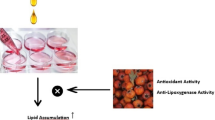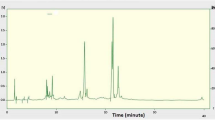Abstract
A large number of plant extracts have demonstrated to provide health benefits and mitigate several disease conditions. However, at the molecular and cellular levels, few studies have been conducted. The present work was designed to study the effect of Myrtus communis leaf extract (ME) (300 mg/kg bw) against hepatotoxicity induced by monosodium glutamate (MSG) (100 mg/kg bw), and acrylamide (ACR) (20 mg/kg bw) in male rats and determining its molecular and cellular mechanisms. The data showed that the treatment with MSG and/or ACR induced significant changes in numerous biomarkers (Bcl-2 and the programmed cell death protein-1) related to liver damage, as recorded by genotoxicity, apoptosis, and histopathological changes. On the other side, the oral administration of ME (300 mg/kg bw) improved the hepatic conditions as confirmed by the improvement in cell viability, programmed cell death, and histopathological alterations. It can be concluded that the consumption of ME might be useful for minimizing the occurred hepatotoxicity through up-regulation of the key apoptotic regulators as well as the improvement of DNA content and cell cycle restoration.

Graphical abstract





Similar content being viewed by others
Abbreviations
- ME:
-
Myrtus communis leaf extract
- MSG:
-
monosodium glutamate
- ACR:
-
acrylamide
- ROS:
-
redox oxygen species
- PD-1:
-
programmed cell death protein-1
References
Agarwal A, Tadros H, Panicker A, Tvrdá E (2016) Role of oxidants and antioxidants in male reproduction. Oxidative Stress and Antioxidant Protection: The Science of Free Radical Biology and Disease: 221–252
Aiello A, Delia D, Borrello MG, Biassoni D, Giardini R et al (1992) Flow cytometric detection of the mitochondrial BCL-2 protein in normal and neoplastic human lymphoid cells. Cytometry Part A 13:502–509
Alalwani AD (2013) Histopathological study on acrylamide induced testicular changes in adult male rats. Am Based Res J 2:2304–7151
Al-Azkawi AS, Al-Bahry SN, Mahmoud IY, Barry MJ (2013) Effect of acrylamide on liver proteins expression in mice. J Food Res 2:132
Belwal T, Devkota HP, Hassan HA, Ahluwalia S, Ramadan MF et al (2018) Phytopharmacology of Acerola (Malpighia spp.) and its potential as functional food. Trends Food SciTechnol 74:99–106
Besaratinia A, Pfeifer GP (2007) A review of mechanisms of acrylamide carcinogenicity. Carcinogenesis 28:519–528
Bhattacharya T, Bhakta A, Ghosh S (2011) Long term effect of monosodium glutamate in liver of albino mice after neo-natal exposure. Nepal Med Coll J 13:11–16
Daniali G, Jinap S, Sanny M, Tan C (2018) Effect of amino acids and frequency of reuse frying oils at different temperature on acrylamide formation in palm olein and soy bean oils via modeling system. Food Chem 245:1–6
Drury RA, Wallington EA (1980) Carleton’s histological technique, 5th edn. Oxford University Press, Oxford, New York, Toronto, pp 188-189, 237–240, 290–291
Durazzo A, Lucarini M, Souto EB, Cicala C, Caiazzo E, Izzo A, Novellino E, Santini A (2019) Polyphenols: a concise overview on the chemistry, occurrence and human health. Phytother Res 33:2221–2243
El-Beltagy AE-FB, Elghaweet HA (2016) Adverse effects of monosodium glutamate on the reproductive organs of adult female albino rats and the possible ameliorated role of carob (Ceratonia siliqua). J Biosci Appl Res 2:170–184
EL-Kholy WM, EL-Sawi MR, Galal NA (2018) Effect of Myrtuscommunis extract against hepatotoxicity induced by monosodium glutamate and acrylamide in male rats. Egypt J Hospital Med 70:1676–1682
Eslami S, Mozdastan S, Ebrahimzadeh M (2016) Antioxidant activity of polyphenol and flavonoid rich extracts from leaves of myrtle (Myrtus communis L.). Pharmacol Online 2:132–136
Fahmy SR, Gaafar K (2016) Establishing the first institutional animal care and use committee in Egypt. Philosophy Ethics Human Med 11(2):1–6
Gedik S, Erdemli ME, Gul M, Yigitcan B, Bag HG et al (2017) Hepatoprotective effects of crocin on biochemical and histopathological alterations following acrylamide-induced liver injury in Wistar rats. Biomed Pharmacother 95:764–770
Ghareeb DA, Khalil AA, Elbassoumy AM, Hussien HM, Abo-Sraiaa MM (2010) Ameliorated effects of garlic (Allium sativum) on biomarkers of subchronic acrylamide hepatotoxicity and brain toxicity in rats. Toxicol Environ Chem 92:1357–1372
Ghorbel I, Elwej A, Jamoussi K, Boudawara T, Kamoun NG et al (2015) Potential protective effects of extra virgin olive oil on the hepatotoxicity induced by co-exposure of adult rats to acrylamide and aluminum. Food Funct 6:1126–1135
Ghorbel I, Elwej A, Chaabene M, Boudawara O, Marrakchi R, Jamoussi K, Boudawara TS, Zeghal N (2017) Effects of acrylamide graded doses on metallothioneins I and II induction and DNA fragmentation: biochemical and histomorphological changes in the liver of adult rats. Toxicol Ind Health 33:611–622
Gülçin I, Beydemir Ş, Topal F, Gagua N, Bakuridze A, Bayram R, Gepdiremen A (2012) Apoptotic, antioxidant and antiradical effects of majdine and isomajdine from Vinca herbacea Waldst. and kit. J Enzyme Inhib Med Chem 27(4):587–594
Hennia A, Nemmiche S, Dandlen S, Miguel MG (2019a) Myrtus communis essential oils: insecticidal, antioxidant and antimicrobial activities-a review. J Essent Oil Res 316:487–545
Hennia A, Nemmiche S, Guerreiro A, Leonor M, Maria F et al (2019b) Antioxidant and antiproliferative activities of myrtus communis l. essential oils from different algerian regions. J Ess Oil Bearing Plants 22(6):1488–1499
Hussein U, Hassan N, Elhalwagy M, Zaki A, Abubakr H et al (2017) Ginger and propolis exert neuroprotective effects against monosodium glutamate-induced neurotoxicity in rats. Molecules 22:1928
Igney FH, Krammer PH (2002) Death and anti-death: tumour resistance to apoptosis. Nat Rev Cancer 2:277–288
Jabri M-A, Marzouki L, Sebai H (2018) Ethnobotanical, phytochemical and therapeutic effects of Myrtus communis L. berries seeds on gastrointestinal tract diseases: a review. Arch Physiol Biochem: 1-7
Jinap S, Hajeb P (2010) Glutamate. Its applications in food and contribution to health. Appetite 55:1–10
Johari H, Nozari M, Moghtari M, Zamani Z, Yazdani M (2014) The effect of Myrtus communis extract on liver enzymes and blood biochemical factors in diabetic adult male rats. Zahedan J Res Med Sci 16:12–17
Kong D, Gong L, Arnold E, Shanmugam S, Fort PE et al (2016) Insulin-like growth factor 1 rescues R28 retinal neurons from apoptotic death through ERK-mediated Bim EL phosphorylation independent of Akt. Exp Eye Res 151:82–95
Mahieu S, Klug M, Millen N, Fabro A, Benmelej A, Contini Mdel C (2016) Monosodium glutamate intake affect the function of the kidney through NMDA receptor. Life Sci 149:114–119
Martinvalet D, Zhu P, Lieberman J (2005) Granzyme A induces caspase- independent mitochondrial damage, a required first step for apoptosis. Immunity. 22:355–370
Mehri S, Abnous K, Mousavi SH, Shariaty VM, Hosseinzadeh H (2012) Neuroprotective effect of crocin on acrylamide-induced cytotoxicity in PC12 cells. Cell Mol Neuro Biol 32:227–235
Mondal M, Sarkar K, Nath PP, Paul G (2018) Monosodium glutamate suppresses the female reproductive function by impairing the functions of ovary and uterus in rat. Environ Toxicol 33:198–208
Muppani NR (2013) Transcriptional regulation of cell life and death decisions by p73: Inst föronkologi-patologi/Dept of Oncology-Pathology
Nicoletti I, Mannucci R, Migloirati G, Riccardi C, Grignani F (2001) Common method for measuring apoptotic cell death by flow cytometry. Purdue Cytom CD-ROM Ser 3:1–9
Obochi G, Malu S, Obi-Abang M, Alozie Y, Iyam M (2009) Effect of garlic extracts on monosodium glutamate (MSG) induced fibroid in Wistar rats. Pak J Nutr 8:970–976
Panjeshahin MR, Azadbakht M, Akbari N (2016) Antidiabetic activity of different extracts of Myrtuscommunis in streptozotocin induced diabetic rats. Romanian J Diabetes Nutr Metabolic Diseases 23:183–190
Quines CB, Chagas PM, Hartmann D, Carvalho NR, Soares FA, Nogueira CW (2017) (p-ClPhSe) 2 reduces hepatotoxicity induced by monosodium glutamate by improving mitochondrial function in rats. J Cell Biochem 118:2877–2886
Raeiszadeh M, Pardakhty A, Sharififar F, Farsinejad A, Mehrabani M et al (2018) Development, physicochemical characterization, and antimicrobial evaluation of niosomal myrtle essential oil. Res Pharmaceutical Sci 13:250
Sabik L (2011) Acrylamide-induced genotoxic, biochemical and pathological perturbations in male rats liver. J Am Sci 7:1092–1096
Safari R, Hoseinifar SH, Van Doan H, Dadar M (2017) The effects of dietary Myrtle (Myrtus communis) on skin mucus immune parameters and mRNA levels of growth, antioxidant and immune related genes in zebrafish (Danio rerio). Fish Shellfish Immunol 66:264–269
Santini A, NovellinoE (2018) Nutraceuticals-shedding light on the grey area between pharmaceuticals and food. Expert Rev Clin Pharmacol 11: 545–547
Snedecor CW, Cochran WC (1980) Statistical methods, 7th edn. The State University Press American, Iowa
Tawfik MS, Al-Badr N (2012) Adverse effects of monosodium glutamate on liver and kidney functions in adult rats and potential protective effect of vitamins C and E. Food Nutr Sci 3:651
Tice RR, Agurell E, Anderson D, Burlinson B, Hartmann A et al (2000) Single cell gel/comet assay: guidelines for in vitro and in vivo genetic toxicology testing. Environ Mol Mutagen 35:206–221
Vermes I, Haanen C, Steffens-Nakken H, Reutellingsperger C (1995) A novel assay for apoptosis flow cytometric detection of phosphatidylserine expression on early apoptotic cells using fluorescein labelled annexin V. J Immunol Methods 184:39–51
Waiz SA, Raies-ul-Haq M, Waiz HA, Gupta S, Pathak A (2015) Preliminary study on the protective effect of vitamin C on monosodium glutamate-induced hepatotoxicity in rats. Comp Clin Pathol 24:1063–1068
Waller RA, Duncan DB (1969) A Bayes rule for the symmetric multiple comparison problems. J Am Stat Assoc 64:1484–1503
Author information
Authors and Affiliations
Corresponding authors
Ethics declarations
Conflict of interest
The authors declare that they have no conflict of interest.
Additional information
Responsible editor: Mohamed M. Abdel-Daim
Publisher’s note
Springer Nature remains neutral with regard to jurisdictional claims in published maps and institutional affiliations.
Electronic supplementary material
ESM 1
(DOCX 708 kb)
Rights and permissions
About this article
Cite this article
Hassan, H.A., EL-Kholy, W.M., EL-Sawi, M.R.F. et al. Myrtle (Myrtus communis) leaf extract suppresses hepatotoxicity induced by monosodium glutamate and acrylamide through obstructing apoptosis, DNA fragmentation, and cell cycle arrest. Environ Sci Pollut Res 27, 23188–23198 (2020). https://doi.org/10.1007/s11356-020-08780-7
Received:
Accepted:
Published:
Issue Date:
DOI: https://doi.org/10.1007/s11356-020-08780-7




